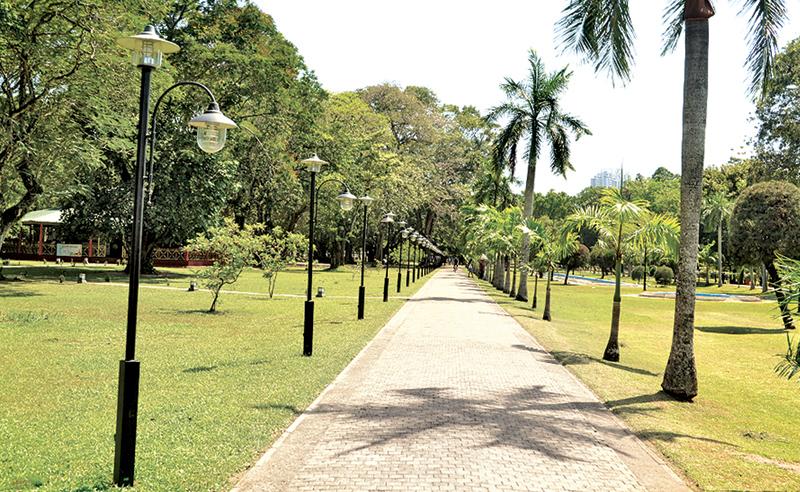
The history of Viharamaha Devi Park can be traced back to the British colonial era when Charles Henry de Soysa donated the land for the park during the reign of Governor Hercules Robinson. In 1897, this park was originally named Victoria Park in commemoration of the Diamond Jubilee of Queen Victoria.
The Assistant Director of the National Archives, Dilini Liyanage says, “Victoria Park was renamed Vihara Maha Devi Park on 18th July 1958 after the authorities erected a statue of Queen Vihara Maha Devi in the park. The former Prime Ministers S.W.R.D. Bandaranaike, Dudley Senanayake, the Minister of Cultural Affairs, Jayaweera Kuruppu, diplomats and a large gathering of the public were also present at this ceremony.
Bandaranaike said the renaming of the park did not mean that Queen Victoria after whom it was originally named had ceased to be held in high esteem. Queen Victoria had contributed outstanding services to her country, and likewise Vihara Maha Devi had rendered services to Ceylon.
 When people enter Vihara Maha Devi Park, they can see a Buddha statue and a rectangular pond with fountains. When they walk a little distance to the left, the statue of Vihara Maha Devi can be found. The statue of Queen Victoria is kept near the National Museum, and the statues of Anagarika Dharmapala and Minister Gamini Dissanayaka were also kept in this Park.”
When people enter Vihara Maha Devi Park, they can see a Buddha statue and a rectangular pond with fountains. When they walk a little distance to the left, the statue of Vihara Maha Devi can be found. The statue of Queen Victoria is kept near the National Museum, and the statues of Anagarika Dharmapala and Minister Gamini Dissanayaka were also kept in this Park.”
In 2014, Vihara Maha Devi Park was renovated under the Metro Colombo Urban Development Project. However, after military occupation during the Second World War (1939 -1945), this park was restored and declared open to the public on 24th August 1951. During the Second World War, the park was occupied by the British army. Liyanage says, “Airstrips were built across the country with the largest at Colombo Racecourse ground during this time. The Ceylon defense forces always occupied large buildings and premises such as grounds to establish camps within Colombo.
The Victoria Park was used by the British Army during World War II and until 1951. Most of the schools operated as military hospitals and barracks during this time. After the end of the First World War, the foundation for the Victory Tower was laid on 7th December 1921 by the Governor Sir William Henry Manning.
It was originally unveiled by the Governor Sir William Henry Manning in Galle Face Green on 27th October 1923. It was dedicated to military personnel who were killed in the World War I. After World War II (Memoriam 1939 – 1945), this tower was moved and rebuilt in Victoria Park to remember military persons who died during the World War II. Now it is next to the Public Library. The names of military persons are displayed in this memorial wall.”
The Victoria Park had a cricket ground which was used for first class cricket matches between Sri Lanka, England and Australia. Liyanage says, “The Sinhalese Sports Club (SSC) which was inaugurated in 1899, leased a land in Victoria Park with sandy soil covered with cinnamon shrubs that was alongside the Colombo Museum. The SSC developed the land into a proper cricket ground, and cricket matches organized by the SSC were played with all the leading clubs in Colombo. Formerly, it was known as Nomads Sports Club Ground.
The National Museum is set on the edge of the 100-acre Victoria Park.Victoria Park was used for both local and international cricket matches. Ceylon played its first match under that name against Marylebone Cricket Club at Nomads Ground, Victoria Park, in 1926–27.Australian team in a 3-day game played against Ceylon at the Nomads Sports Club Ground at Victoria Park, Colombo in October in 1935. England played against Ceylon at the Nomads Ground in Victoria Park, Colombo in 1936-1937.”
The Viharamahadevi Park is one of the oldest and largest parks in Sri Lanka and the main features of the park include landscaped gardens with a variety of trees, flowers and small ponds.There are many areas in this park such as open air stadium, picnic area, children’s play area, summer hut, band stand, lake with a suspension bridge, aquarium, jogging tracks, cycle tracks, paved pathways and seating places. In the past, the park had a mini zoo but at present there is no zoo but a few horses can be seen.
There are lots of things to do for children including a large playground full of slides, see-saws, swings and a kiddie’s fun park and an infant play area in the children play area.
The Viharamahadevi Park is currently used for concerts and public events, jogging, political meetings and other meetings, shooting films and tele-dramas, local and foreign cultural shows, relaxing and selling plants. The park is patronized by families, children, adults, lovers, joggers, students and researchers.
Pix: Vipula Amarasinghe
